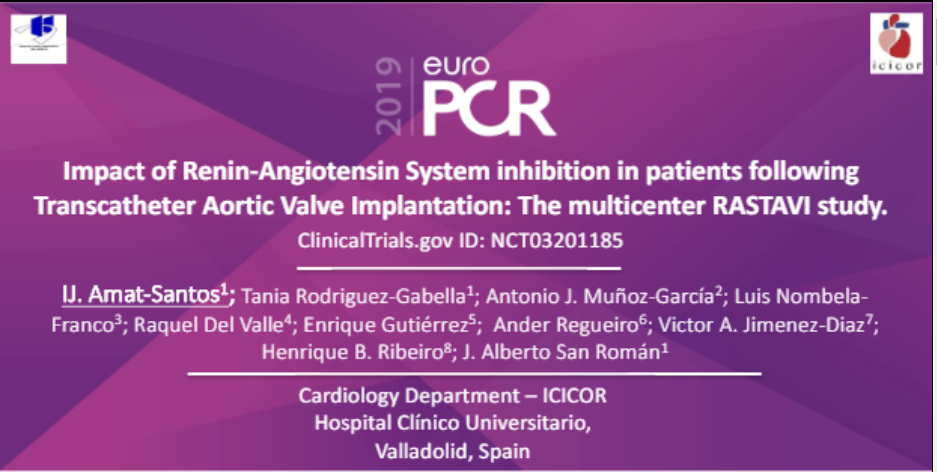RAS Inhibition After TAVR Gains More Support, but RCT Still Needed
“If your patient already has an indication for RAS inhibition, you should definitely strongly be considering that post-TAVR,” one expert says.

Renin-angiotensin system (RAS) blockade may improve clinical outcomes in patients with severe aortic stenosis who undergo successful TAVR, observational data suggest.
Patients prescribed a RAS inhibitor at discharge have lower rates of CV death, new-onset atrial fibrillation, cerebrovascular events, and readmissions over the next 3 years, lead author Tania Rodriguez-Gabella, MD (Hospital Clínico Universitario, Valladolid, Spain), and colleagues report.
Also, echocardiographic data from the study show that RAS blockade is associated with a greater degree of positive LV remodeling, providing a potential mechanistic explanation for the observed differences in clinical outcomes.
The findings, initially presented earlier this year at EuroPCR, were published online ahead of the August 6, 2019, issue of the Journal of the American College of Cardiology.
Senior author Ignacio Amat-Santos, MD, PhD (Hospital Clínico Universitario), acknowledged that the results—deemed hypothesis-generating in the paper—need to be confirmed in a randomized trial, noting that his group is currently recruiting patients for just such a trial (called RASTAVI).
In the meantime, Amat-Santos told TCTMD, “I think we can say with some data on our hands that if one of our TAVR patients needs to receive antihypertensives, probably RAS inhibitors are the best option for them because there is not only a reduction in blood pressure but also a potential beneficial effect in the myocardium. This needs to be verified, but I think we already have enough data to start suggesting this treatment.”
I think we can say with some data on our hands that if one of our TAVR patients needs to receive antihypertensives, probably RAS inhibitors are the best option for them. Ignacio Amat-Santos
This new analysis adds to a growing evidence base regarding use of RAS blockade after TAVR, according to Sreekanth Vemulapalli, MD (Duke Clinical Research Institute, Durham, NC), who was the senior author of another study showing that use of the agents was associated with lower risks of all-cause death and hospitalization for heart failure.
“I view it as a nice confirmation, another piece to the story of how we think RAS blockade would work post-TAVR,” Vemulapalli told TCTMD, adding that the study extends previous findings by demonstrating differences in CV mortality and cerebrovascular events as well as effects on LV remodeling.
Like Amat-Santos, he underscored the importance of a randomized trial, but Vemulapalli also said: “If your patient already has an indication for RAS inhibition, you should definitely strongly be considering that post-TAVR. So that’s probably the safe recommendation.”
And beyond that, “strong consideration should be given” to starting RAS inhibitor therapy after TAVR in patients without other indications for such treatment as long as there are no contraindications, he added. “But that’s going to be on a case-by-case basis. We don’t have prospective data to support that just yet.”
RASTAVI Registry
Amat-Santos said he and his colleagues decided to look more into post-TAVR medical therapy as the procedure started to be increasingly used in younger, lower-risk patients, finding that even though there are numerous studies regarding antithrombotic therapy, there is little research into other types of medications. RAS inhibitors specifically may be beneficial in patients with severe aortic stenosis, he added, because it is known that the presence of persistent LV hypertrophy and myocardial fibrosis—which can be mitigated by the agents—after TAVR is associated with a worse prognosis.

After propensity-score adjustment, patients who did versus did not receive RAS inhibitors had a lower rate of CV mortality at 1 year, a difference that persisted at 3 years (7.2% vs 11.3%; P = 0.006). On multivariate analysis, the only factor independently associated with a lower CV mortality risk was RAS blockade (HR 0.59; 95% CI 0.41-0.87).
There was no difference between groups in all-cause mortality (18.4% vs 19.6%; P = 0.567), but RAS inhibition was associated with lower rates of new-onset A-fib, cerebrovascular events, and readmissions.
At the 3-year follow-up, 85.5% of patients were assessed with transthoracic echocardiography, and an analysis of those findings showed greater reductions in LV end-diastolic and end-systolic volumes and septal hypertrophy over time in those who received RAS blockers.
Potential Mechanisms of Benefit
Those echo changes indicate that RAS inhibition may be improving clinical outcomes after TAVR by having a positive effect on LV remodeling, Amat-Santos said. It’s also possible that treatment is reducing fibrosis, he added, although most patients in the RASTAVI registry were not evaluated with MRI. The ongoing randomized trial includes MRI assessments to help resolve this question.
Vemulapalli said that because patients who received RAS inhibitors were more likely to have a variety of conditions that are indications for such therapy—including diabetes, hypertension, and coronary disease—it’s unclear whether the differences in clinical outcomes are due to positive LV remodeling and a reduction in fibrosis or simply just a lowering of blood pressure.
“It may have some antihypertensive effect, but I do believe—especially based on the echo data they’ve shown here—that there is some reverse remodeling that’s happening,” Vemulapalli said. Prior data from the PARTNER trial show that there is reverse remodeling after successful TAVR, he noted. “But there seems to be more reverse remodeling that’s happening with the use of RAS inhibition, so I do suspect that that’s at least part if not the majority of the reason we’re seeing this. But again, this is all based on observational data and we need a prospective confirmation via trial.”
Amat-Santos said the trial will also be important for assessing the potential risks of RAS inhibition in a post-TAVR setting—specifically, hypotension and renal-function decline. This observational analysis did not show any concerning signals regarding renal function, but questions still remain about hypotension because blood pressure was not systematically monitored. That will be done in the trial.
However, Amat-Santos said, “we don’t expect this kind of impact because we see that cardiovascular mortality is reduced, so there is no clue that suggests that hypotension might have a clinical impact in these patients.”
In an accompanying editorial, Russell Everett, MD, PhD, and Marc Dweck, MD, PhD (both University of Edinburgh, Scotland), also stressed the need for randomized data, pointing to several limitations of the observational analysis.
“The results [of the RASTAVI trial] are eagerly awaited and could provide clinicians with the first evidence-based medical treatment targeting myocardial remodeling in aortic stenosis,” they say.
Todd Neale is the Associate News Editor for TCTMD and a Senior Medical Journalist. He got his start in journalism at …
Read Full BioSources
Rodriguez-Gabella T, Catalá P, Muñoz-García AJ, et al. Renin-angiotensin system inhibition following transcatheter aortic valve replacement. J Am Coll Cardiol. 2019;74:631-641.
Everett RJ, Dweck MR. Renin-angiotensin system inhibition in aortic stenosis: thinking beyond transcatheter aortic valve replacement. J Am Coll Cardiol. 2019;74:642-644.
Disclosures
- The study was supported by Insituto de Salud Carlos III.
- Rodriguez-Gabella, Amat-Santos, Vemulapalli, Everett, and Dweck report no relevant conflicts of interest.


Comments